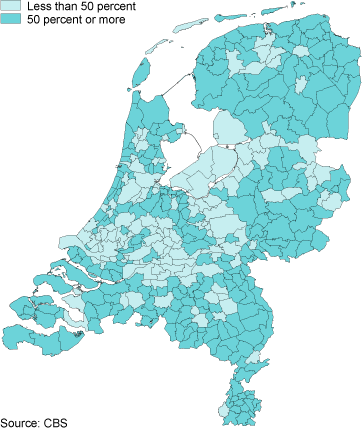Teenage population will fall in next 10 years, but rise in Randstad

According to Statistics Netherlands’ population forecast, the number of teenagers in the Netherlands will decrease by 160 thousand in the next ten years. This would mean that just under 1.9 million 10-19 year-olds will be living in the Netherlands in 2025. The number of 10-14 year-olds in particular will drop sharply from its present number. The regional forecast compiled by Statistics Netherlands and the Netherlands Environmental Assessment Agency (PBL) expects the number of teenagers to grow in a large part of the Randstad area in the west of the Netherlands, while the largest decrease is expected for a number of peripheral regions.
Decrease mainly in 10-14 year-old age group
According to the most recent population forecast, the number of 10-19 year-olds in the Netherlands will fall to below 1.9 million in 2025. This decrease reflects the fall in the number of births since the turn of the millennium. It follows a period in which - after an increase from the mid-1990s - the number of teenagers had stalled at around 2 million. The number of 10-14 year-olds is expected to fall from just over 1 million to 904 thousand, a decrease of 11 percent. The decrease foreseen for 15-19 year-olds is considerably smaller, at 5 percent. Their number will diminish from 995 thousand in 2014 to 947 thousand in 2025.
Number of teenagers (including forecast)

Nearly 974 thousand of all Dutch 10-19 year-olds were in secondary education in school year 2013/’14. Just as the decrease in the number of primary school pupils, the expected reduction in the number of teenagers will have its effects on various social aspects of the young population, including participation in education.
Decrease in large parts of the country, increase in Randstad
Nearly all areas of the country will be affected by the expected decrease in the number of teenagers up to 2025. The largest decreases will be in northern North Holland, the Achterhoek in the east of the country, Zeeuws-Vlaanderen in the southwest, the area around Delfzijl in the north, and Zuid-Limburg in the south. Only in five regions in the Randstad area in the west of the country is the teenage population expected to increase: The Hague agglomeration, greater Amsterdam, Haarlem agglomeration, Zaanstreek to the north of Amsterdam, and Delft and Westland. In Utrecht and in the Rotterdam agglomeration the number of teenagers will decrease.
The regional differences in foreseen changes in the teenage population correlate with regional differences in the number of births. The older a population is in a certain region, the lower the number of births will obviously be. In addition, many young people move to university cities, which also contributes to regional variation. These differences will also have effects at the regional level for the capacity of institutes for further education and sports and recreational provisions.
Number of teenagers per COROP area, 2014-2025

In September, Statistics Netherlands reported that in 264 Dutch municipalities more than half of the adult population were older than 50 on 1 January 2014. These municipalities are mainly in the part of North Holland north of Amsterdam, Friesland, Groningen, Drenthe, the Achterhoek and Twente (in the east), Zuid-Limburg and southern North Brabant in the south of the country, and Zeeland.
Share of over-50s in adult population
